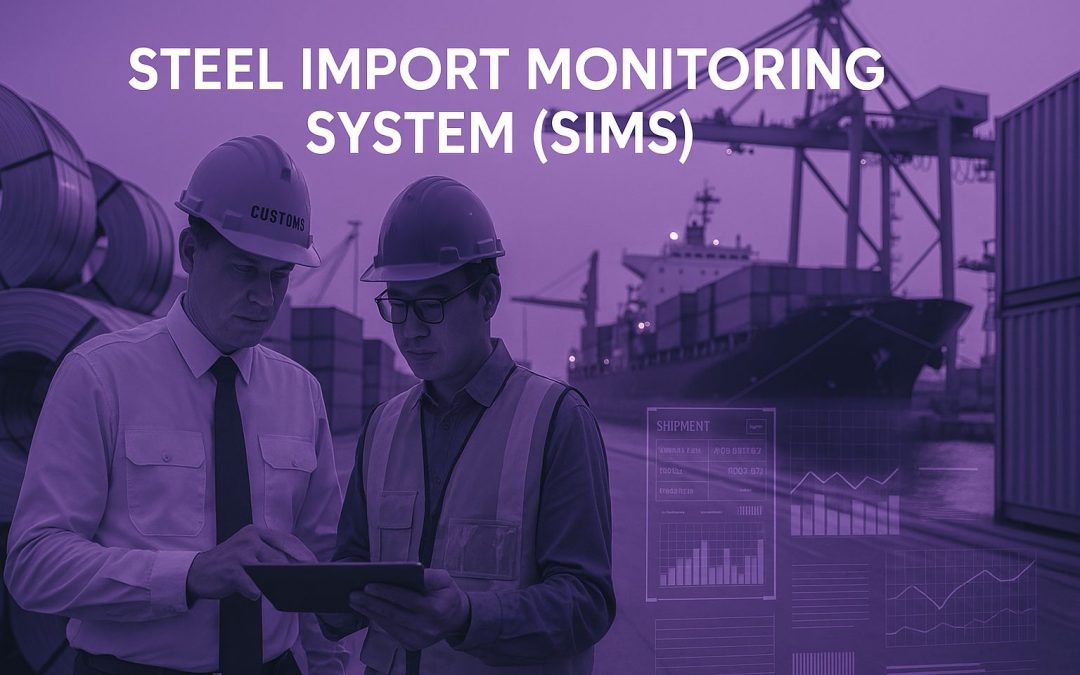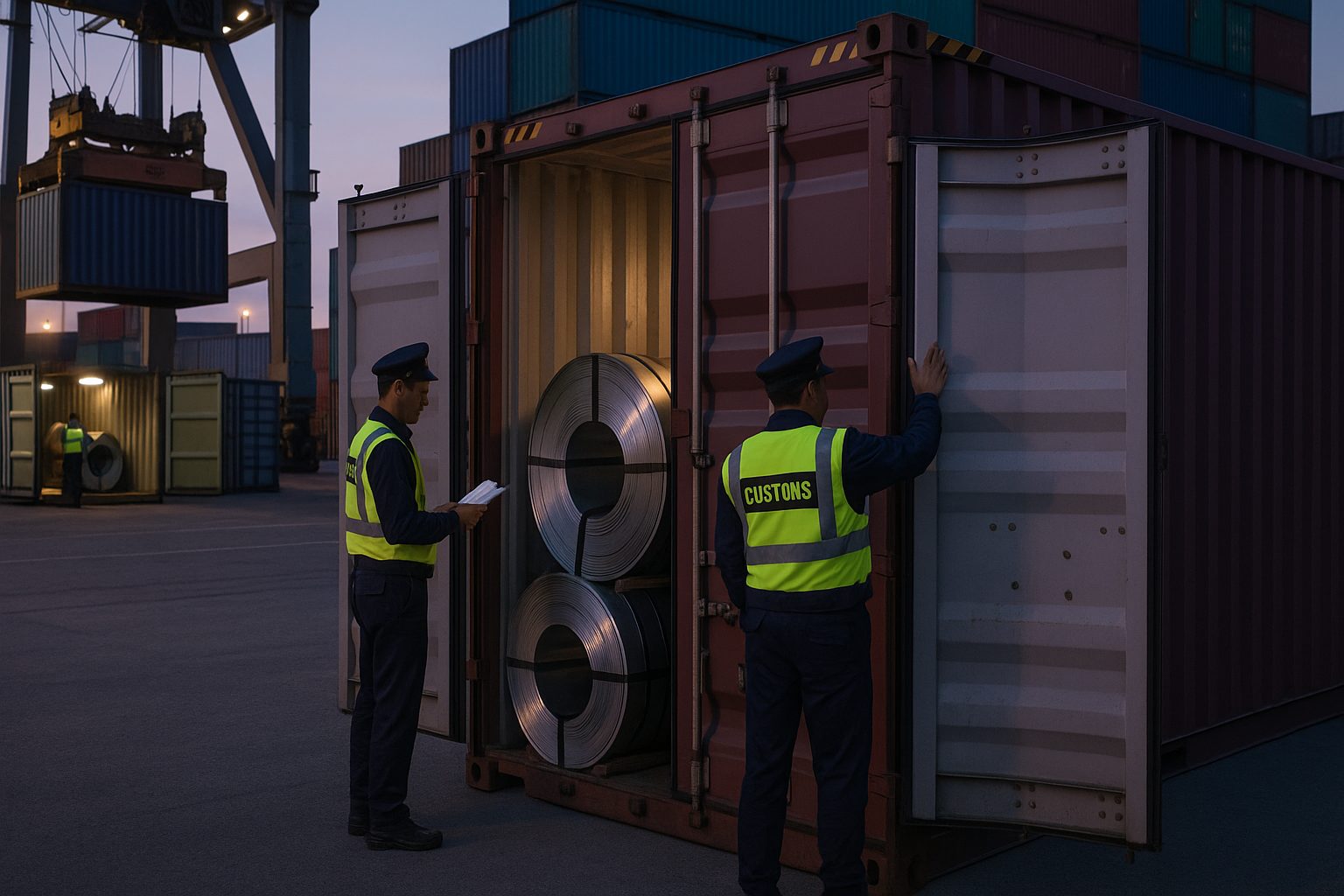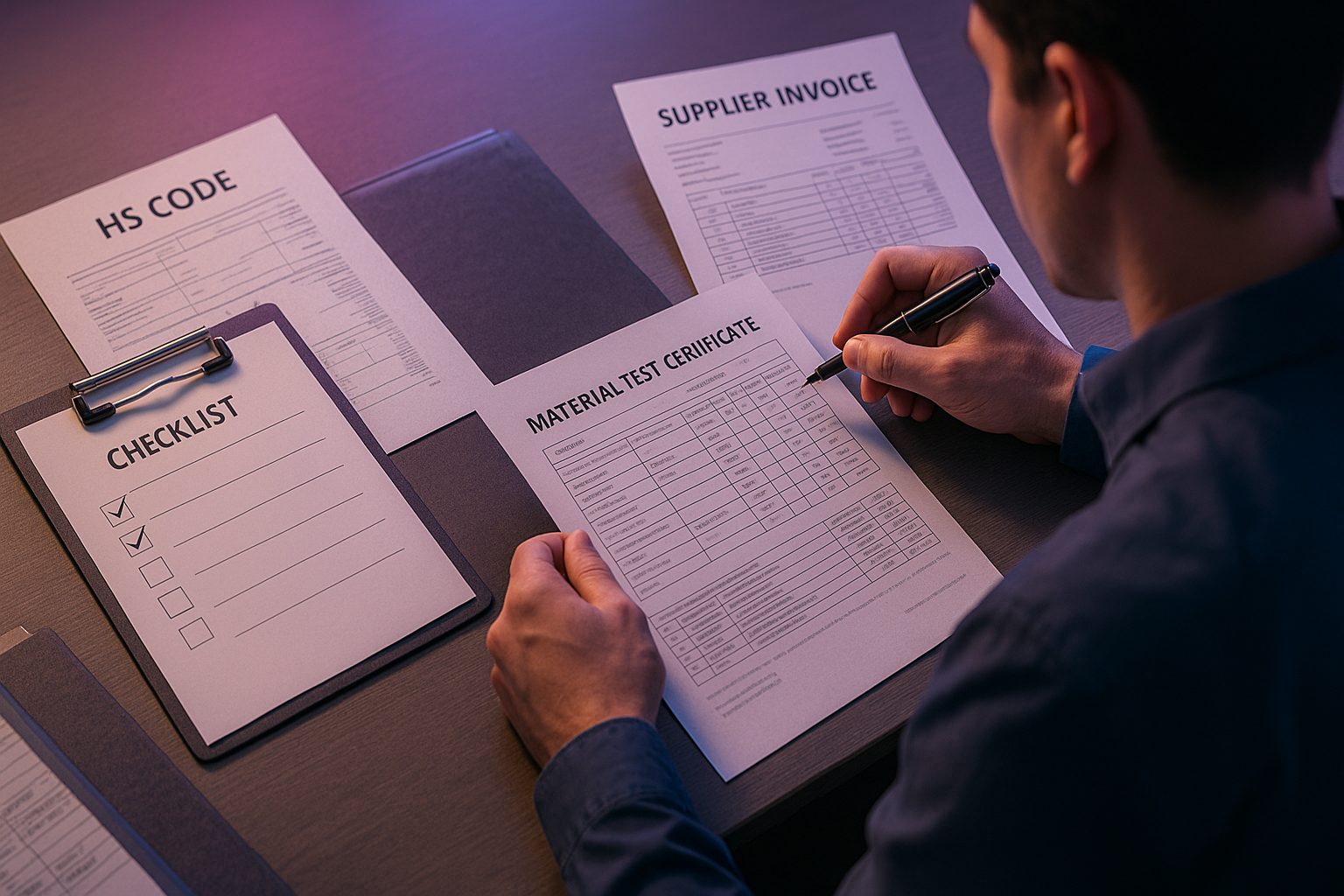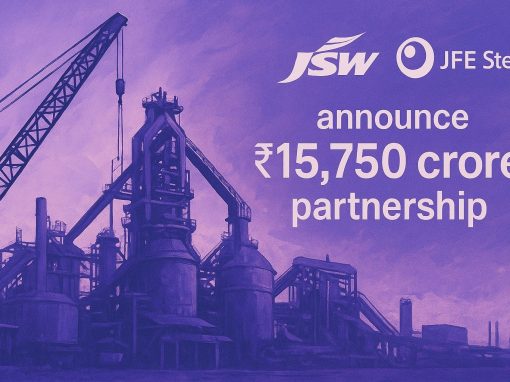Table of Contents
- Introduction
- What is SIMS and Why was it Introduced?
- Without SIMS vs with SIMS
- SIMS Importance for MSMEs
- Steel Products that require SIMS Registration
- How to File SIMS Registration
- SIMS Filing Fees, Validity Period & Approval Time
- What the Latest 2025 Update Means for MSMEs
- How SIMS Affects Steel Prices, Landed Cost & MSME Procurement
- SIMS Compliance Checklist for MSME Steel Importers
- Conclusion – SIMS is Not Complicated when you Understand its Logic
- FAQs
Introduction
Importing steel into India is no longer a simple port-to-warehouse transaction. Every shipment, no matter how small, now passes through a mandatory digital checkpoint called the Steel Import Monitoring System (SIMS). It was introduced to track real-time steel import trends, prevent unfairly priced inflows, and give the government early visibility into trade behaviour. But in day-to-day business terms, SIMS impact businesses more directly. From costing sheets to shipment timelines to compliance paperwork. In 2025, SIMS has gained even more relevance. India has seen a steady rise in low-priced imports from Korea, Vietnam, and Russia, triggering repeated government reviews.
Steel Import Monitoring System is not a complex system, but non-compliance can block a shipment at the port, delay customs filing, or force last-minute penalty payments. Many MSMEs still treat it as a formality, yet it is a crucial step that needs to be planned at the same time as the purchase order.
This guide breaks SIMS down into clear parts – what it is, why it was created, how it works, and what MSMEs need to do before placing or receiving an import order in 2025.
What is the Steel Import Monitoring System (SIMS) and Why was it introduced?
Steel Import Monitoring System (SIMS) is a digital reporting framework in India that tracks every incoming shipment of iron and steel before it enters the country. It was introduced by the Directorate General of Foreign Trade (DGFT) and SIMS was designed to provide policymakers early visibility of import trends, volumes, origins, etc. This is something earlier systems failed to provide in real time.
The core purpose of this system is to bring predictability. Instead of learning about import surges months later through customs data, the government receives advance information on:
- which grades of steel are being imported
- from which countries
- in what quantities
- and at what indicative prices
Thus, Steel Import Monitoring System helps regulators monitor unfair pricing, detect sudden inflow spikes, understand pressure points that may affect domestic manufacturers, and so on.
Without SIMS vs With SIMS (at a glance)
| Factor | Without SIMS | With SIMS |
| Customs | Likely delay | Smooth clearance |
| Cost | Higher demurrage | Lower landed cost |
| Pricing | Uncertain | More predictable |
| Supplier trust | Poor | Stronger documentation |
How SIMS helps the government track steel inflow
SIMS collects shipment-level data before the cargo leaves the exporting country. This pre-shipment reporting enables:
- Real-time tracking of sensitive categories like HRC, CRC, colour coated coils, and structural steel
- Early detection of dumping patterns from specific origins
- Better planning of trade measures such as quality controls, duties, or safeguard actions
- Improved demand-supply mapping for infrastructure and manufacturing-led planning
For policymakers, Steel Import Monitoring System acts as a dashboard. For businesses, it becomes part of the documentation trail that supports transparency in the steel supply chain.
SIMS importance for MSME buyers
For businesses that import steel directly or buy from traders who import regularly, then Steel Import Monitoring System influences commercial outcomes in three ways, which include:
- Price predictability
Tracking volumes and origins helps the government intervene early if imports rise sharply. That stabilises market prices and minimises sudden spikes. It is critical for MSMEs preparing quotes or bidding for tenders. - Supply continuity
With advance visibility of cargo movement, ports, customs, etc. they can manage congestion better. Thus, reducing delays that often increase detention and demurrage. In import-heavy grades, this reduces project disruptions. - Quality assurance
SIMS reporting requires mill name, product type, and HS code details. This improves traceability, making it harder for low-grade or misclassified material to enter the supply chain. And hence becoming an advantage for MSMEs supplying EPC, infra, or quality-audited sectors.
Which steel products need SIMS registration?
SIMS applies to a wide set of iron and steel products that enter India under specific HS codes notified by DGFT. The idea is simple: any item that can significantly influence domestic pricing, quality standards, or supply balance must be declared before import. For businesses, this means checking product codes carefully, and also before finalising a shipment.
Here’s the following broad steel product categories that require Steel Import Monitoring System registration:
Flat steel products
- Hot-rolled coils and sheets
- Cold-rolled coils and sheets
- Galvanised and coated coils
- Plates of various thickness
These items influence pricing for automotive, fabrication, engineering, and infrastructure MSMEs.
Long steel products
- Rebars and rods
- Wire rods
- Structural sections (angles, channels, beams)
These products directly affect construction, EPC, and manufacturing units.
Semi-finished and intermediary steel
- Billets, blooms, slabs
- Stainless steel flats and longs
- Electrical steel (CRGO/CRNO)
These categories are monitored due to rising imports and quality-sensitive applications.
Also read: Tata Steel products list/catalogue
Simplified HS code guidance
SIMS covers items broadly falling under HS Code Chapters 72 and 73. While MSMEs do not need to memorise long code lists, they should verify:
- HS code on the supplier’s proforma invoice
- Whether the product falls under DGFT’s SIMS notification
- If the item is classified as a sensitive import category
A simple rule: If your steel item is standard flat, long, stainless, electrical, or coated steel – it almost certainly needs SIMS.
Products that do NOT require SIMS
A few niche categories fall outside SIMS:
- Tools and alloy items not classified as steel raw material
- Machinery, equipment, fabricated steel products
- Scrap metal (imported under separate procedures)
- Small hardware items (nuts, bolts, washers) unless misclassified as steel
Still, MSMEs are advised to double-check, since misclassification is a common reason for customs delay.
How to File SIMS Registration (Step-by-Step Guide for MSMEs)
SIMS registration is a mandatory pre-import filing that must be completed before the steel shipment leaves the exporting country. For MSMEs, the process is straightforward when documents are ready, but delays usually happen due to missing details or incorrect HS codes. Let’s have a detailed look at the exact workflow on the DGFT portal.
Step-by-step SIMS filing process
Step 1: Visit the SIMS portal
Go to the official DGFT portal: https://www.dgft.gov.in
Under the “Services” tab, select Steel Import Monitoring System (SIMS).
Step 2: Login with IEC credentials
Importers must log in using:
- IEC number
- Linked mobile/email OTP
If an MSME relies on a CHA or consultant, ensure the login access is shared securely.
Step 3: Select ‘File New SIMS Registration’
Now a digital filing form window will open where all import details must be entered.
Step 4: Fill in product and shipment details
The importer must enter:
- HS code (as per invoice)
- Product description
- Mill name and country of origin
- Quantity
- CIF value
- Port of arrival in India
- Expected date of arrival
SIMS must be filed at least 7 days before the consignment’s arrival.
Step 5: Upload required documents
Most MSMEs only need to upload the proforma invoice.
In some cases, supplier declarations may be requested.
Step 6: Pay the SIMS fee
The portal auto-calculates the fee. Payment is made through net banking or cards.
Step 7: Submit and download the SIMS Registration Number
Once processed, the system generates a unique SIMS Registration Number (SRN).
This must be shared with your CHA and attached to the Bill of Entry during customs clearance.
A quick summary for SIMS filing
| Steps | What you need to do | Key inputs required |
| 1 | Visit DGFT SIMS Portal | https://www.dgft.gov.in |
| 2 | Login using IEC | IEC, OTP |
| 3 | Start new SIMS application | Select “File New Registration” |
| 4 | Enter shipment details | HS code, quantity, CIF value, port, ETA |
| 5 | Upload documents | Proforma invoice |
| 6 | Pay fee | ₹1 per ₹1,000 of CIF value (min ₹500, max ₹1 lakh) |
| 7 | Download SIMS number | Share with CHA for customs |
Common mistakes MSMEs must avoid
- Incorrect HS code selection
- Filing SIMS after the shipment leaves origin
- Using outdated supplier invoice details
- Forgetting to share the SIMS number with the CHA
- Not checking the validity period
Even one small error can delay the Bill of Entry, which increases demurrage and storage cost at ports.
SIMS Filing Fees, Validity Period & Approval Time
SIMS is designed to be a low-cost compliance requirement, and for most MSMEs the fee is minimal compared to the value of the shipment. What matters is understanding how long the registration stays valid and when to file to avoid clearance delays.
SIMS Fee Structure
DGFT charges a nominal fee calculated on the CIF value of the shipment.
Fee formula
- ₹1 per ₹1,000 of CIF value
- Minimum fee: ₹500
- Maximum fee: ₹1,00,000
For example, if an MSME is importing steel worth ₹12 lakh (CIF), the SIMS fee will be ₹1,200.
Processing time
SIMS approval is not manual.
Once the form and fee are submitted, approval is instant, and the registration number is generated within minutes.
However, MSMEs must still file well in advance because the real risk lies in missing the mandatory timeline.
SIMS Validity
A SIMS number is valid for:
- 75 days from the date of filing, or
- Until the shipment arrives in India,
whichever is earlier.
If the shipment is delayed beyond this period, a fresh Steel Import Monitoring System registration must be done.
A quick reference to: SIMS Fee + Validity
| Parameter | Value |
| Fee formula | ₹1 per ₹1,000 of CIF value |
| Minimum fee | ₹500 |
| Maximum fee | ₹1,00,000 |
| Processing time | Instant (auto-generated) |
| Validity | 75 days from filing date |
| Filing deadline | Must be filed ≥7 days before cargo arrival |
Penalties & Risks of SIMS Non-Compliance
In case businesses fail to file SIMS or file it incorrectly does not just result in a fine. But, the bigger risk lies in shipment delays, higher port charges, missed delivery commitments, etc. As for businesses these delays can trigger heavy commercial losses by delaying the supply to EPCs, OEMs, government tenders, etc.
Let’s have a quick glance at the key consequences of SIMS non-compliance.
Customs holds and clearance delays
If SIMS is not filed at all or if filed but with incorrect details, customs will not process the Bill of Entry.
This leads to:
- Shipments getting stuck at the port
- Containers moved to bonded warehouses
- Storage charges increasing every day
For steel items that already have high volume and weight, delay-related costs escalate rapidly.
Financial penalties
DGFT and customs may impose monetary penalties in cases where:
- SIMS was not filed
- Wrong HS code was declared
- Incorrect quantity or product description was submitted
Penalties typically fall within the ₹10,000 to ₹1,00,000 range depending on the severity and frequency of violation.
Risk of shipment detention
If the discrepancy is major, the shipment can be moved to a “red channel” for additional inspection.
This not only delays clearance but increases costs such as:
- Detention
- Demurrage
- Additional warehousing
- CHA handling surcharges
These charges often exceed the SIMS fee by 10x or more.
Disruption in MSME tender execution
Many MSMEs import steel to meet delivery requirements for:
- Railways
- Metro projects
- EPC contractors
- Defence-related suppliers
- State infrastructure departments
A delay due to a missing SIMS filing can:
- Push the MSME into contract breach
- Lead to LD (liquidated damages) deductions
- Trigger blacklisting risk for repeat delays
For time-bound tenders, SIMS non-compliance becomes a business risk, not just an import issue.
Supplier payment complications
When shipments are delayed, MSMEs often face:
- Disputes with overseas suppliers
- Delayed payment cycles
- Bank LC or advance payment issues
Most foreign mills and traders do not accept delays caused by Indian regulatory non-compliance.
Why compliance matters
SIMS is not an optional formality. For import-dependent MSMEs, it is a safeguard that protects both pricing predictability and supply-chain continuity. The small filing effort is far cheaper than the operational losses that follow non-compliance.
Latest November 2025 Update
November 16, 2025
The government has proposed a major revamp of the Steel Import Monitoring System (SIMS) to speed up import clearances and simplify consignment filing. Planned changes would ease SIMS registration and minimises repetitive declarations, that could lower clearance delays and affect landed-cost timing for MSME steel buyers. (Source: Economic Times)
What this update means for MSME steel buyers
- Fewer registration headaches
Until now, each shipment (even small ones) required separate SIMS filings. With this proposed change, now, MSMEs using frequent imports may soon use a single registration per year. Thus, reducing admin time and cost.
- Faster customs clearance
With simplified declarations, ports and customs are likely to prioritise clearance of steel consignments – meaning less risk of demurrage or storage costs due to regulatory delays.
- Better landed-cost predictability
When import compliance is smoother, buyers can factor in fewer hidden delays or extra charges – enabling better quotations and supplier negotiations.
- Aligned with low-price cycle
Given current steel rates at nearly five-year lows, this update makes strategic sense for MSMEs. If imported material clears faster and at lower cost, buyers can gain real advantage. On the flip side, delays or mis-filings will now stand out even more.
Action-for-MSMEs: What you should do now
- Check your current SIMS registration status – anticipate when you can switch to annual registration.
- Ask your CHA/import agent about the new rule – whether they are ready to use fewer filings.
- Review your delivery pipeline – if you process frequent imports, examine whether a single registration route works for you.
- Update your internal procurement policy – reflect this change so your steel buying team can plan more confidently.
How SIMS Affects Steel Prices, Landed Cost & MSME Procurement
Steel Import Monitoring System is not a pricing tool, but it indirectly shapes market sentiment and cost outcomes for Indian buyers. When compliance becomes predictable and data becomes transparent, pricing behaviour across the supply chain shifts. For MSMEs, this affects how much they pay, how quickly they receive raw material, and how stable their sourcing becomes.
Faster clearance reduces hidden logistics costs
Usually, most businesses underestimate the impact of port delays on pricing. But, when SIMS filings are correct and processed early, then:
- Bills of Entry move quicker
- Containers spend less time in storage
- CHA charges stay under control
- Trucks are scheduled without last-minute rescheduling
Further, these factors directly influence landed cost. And even a two-day delay can raise cost by ₹400-₹700/ tonne for steel. Thus, with improved SIMS efficiency, such cost leakage reduces.
Higher import visibility stabilises domestic prices
SIMS provides early warnings of import surges. When authorities monitor inflows closely, then:
- Dumping becomes harder
- Mills adjust production proactively
- Traders receive clearer price signals
This reduces extreme upward price spikes – critical for MSMEs that plan quotations weeks in advance.
For import-dependent grades like CRC, coated coils, or stainless steel, transparent inflow data helps flatten price volatility.
More imports during low-price cycles keep market soft
When international prices fall and imports rise, domestic mills face pressure to maintain their price competitiveness. SIMS ensures this pattern is visible earlier, which means:
- Domestic mills offer sharper discounts
- Local distributors clear stock faster
- MSME buyers get more negotiation power
This is especially relevant now, as steel prices have dropped to a five-year low and the market remains sensitive to import behaviour.
Predictable supply improves tender pricing
Businesses supplying EPC, metro, railway, infra sectors, etc. directly depend on fixed predicted delivery timelines. This as a result, is improved through SIMS and:
- Buyers can lock in tenders confidently
- LD (liquidated damages) risk reduces
- MSMEs can quote lower buffer margins
Moreover, better predictability also supports competitive bidding without exposing the business to cost overrun risks.
Reduction in documentation errors lowers cost creep
Incorrect filings often create compounding costs:
- Re-filing fees
- CHA rework
- Penalties for wrong HS codes
- Extended storage or detention
Stronger SIMS compliance means fewer of these errors, which directly helps MSMEs maintain tight procurement budgets.
SIMS Compliance Checklist for MSME Steel Importers
Steel Import Monitoring System compliance is smooth when the required details are ready in advance. The most common delays happen because MSMEs begin filing only after the vessel is booked. A structured checklist helps avoid last-minute errors and ensures the Bill of Entry moves through customs without interruption.
Below is a practical pre-import checklist your procurement and CHA teams can follow.
HS Code Confirmation
- Cross-check HS code with the supplier’s proforma invoice
- Verify that the code falls under DGFT’s SIMS-notified list
- Ensure there is no mismatch between invoice description and HS code
Even a minor error here can shift your shipment to the red-channel.
Supplier Documentation
- Proforma invoice
- Mill test certificate (if issued at origin)
- Country-of-origin declaration
- Expected date of shipment
SIMS entries must match the supplier’s documents exactly.
Import Quantity & Schedule
- Confirm exact metric tonne quantity
- Ensure ETD (export date) and ETA (arrival date) are realistic
- SIMS must be filed at least 7 days before arrival
If your supplier ships earlier than planned, the filing may become invalid.
Buyer Details
- IEC
- GST
- PAN
- Importer address
- Bank details linked to IEC
These must match DGFT records to avoid system errors.
Port of Entry Verification
- Select the correct Indian port in SIMS
- Ensure it matches shipping documents
- Changing ports later may require re-filing
CIF Value and Currency Conversion
- Confirm CIF value with supplier
- Check currency conversion rate used while filing
- Mistakes here create issues during customs assessment
CHA Coordination
- Share SIMS number immediately after filing
- Confirm that it is attached to the Bill of Entry
- Ensure the CHA is aware of validity timelines
Many delays happen because the SIMS number is not passed to the CHA on time.
Ready-to-use SIMS Checklist
| Checklist item | What to verify | Why it matters |
| HS Code | Matches invoice + DGFT list | Prevents customs hold |
| Quantity | Exact MT listed | Wrong quantity leads to re-filing |
| CIF Value | Matches supplier quote | Avoids customs assessment mismatch |
| Port of Entry | Same as shipping docs | Prevents re-filing |
| ETA | At least 7 days buffer | Required under SIMS rules |
| Buyer Details | IEC, GST, PAN linked | System validation |
| Supplier Docs | Invoice + MTC | Traceability |
| CHA Alignment | SIMS no. shared | Smooth BoE processing |
Conclusion – SIMS is not Complicated when you understand its Logic
Steel Import Monitoring System often appears like another layer of paperwork, but once MSMEs understand its structure, it becomes a predictable and manageable part of the import cycle. As the system was designed to bring transparency to steel inflows, safeguard domestic industry, and at the same time streamline customs planning. For buyers, the real benefit lies in avoiding preventable delays and keeping landed costs under control.
When documents are aligned, HS codes are accurate, and filings are completed ahead of time, SIMS works smoothly. Most operational problems arise only when the filing is rushed or the importer depends on last-minute coordination with suppliers or CHAs. A disciplined approach removes this uncertainty.
For MSMEs that import steel regularly or participate in EPC, metro, infrastructure supply chains, etc. then, SIMS compliance help strengthens delivery reliability. Apart form it, as steel prices stay volatile and import patterns shift, this predictability becomes a competitive advantage rather than a procedural requirement.
In essence, SIMS is not a hurdle. It is a planning tool. And MSMEs that treat it that way will protect margins, maintain timelines, and compete more confidently in both domestic and tender-driven markets.
Looking to procure steel?
Tata nexarc helps manufacturers, builders and MSMEs source certified steel products, compare prices, and choose the right grade as per IS codes—with complete traceability and procurement confidence.
FAQs
Does SIMS apply if I buy steel through a domestic trader who imports it?
Can SIMS be filed after the shipment departs the exporting country?
Is SIMS required for trial/import samples for testing?
Is SIMS mandatory for stainless steel imports?
Can SIMS be edited after submission?
What happens if the shipment arrives earlier than planned?
Does SIMS apply if the steel is used for export production?
Does SIMS cover fabricated steel products (like PEB components)?
Is SIMS needed for importing coated or colour-coated steel coils?
Charul is a content marketing professional and seasoned content writer who loves writing on various topics with 3 years of experience. At Tata nexarc, it has been 2 years since she is helping business to understand jargon better and deeper to make strategical decisions. While not writing, she loves listing pop music.














